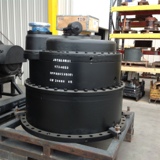Title Page
-
Site conducted
-
Prepared by
-
Conducted on
-
Personnel Audited
Audit Preparation
Audit Preparation
-
Review previous report from Internal Audit
-
Review corrective actions for previous Internal Audit findings (if any)
-
Previous CAR Numbers
-
-
Review previous observation findings
-
Review work instructions, forms, & procedures that pertain to audit area
-
Enter Work Instruction Number / Form
-
-
Enter Work Instruction Number / Form
-
-
Enter Work Instruction Number / Form
ISO 9001: 2015 SCOPE:
-
Scope
This International Standard specifies requirements for a quality management system when an organization:
a) needs to demonstrate its ability to consistently provide products and services that meet customer and applicable statutory and regulatory requirements, and
b) aims to enhance customer satisfaction through the effective application of the system, including processes for improvement of the system and the assurance of conformity to customer and applicable statutory and regulatory requirements.
All the requirements of this International Standard are generic and are intended to be applicable to any organization, regardless of its type or size, or the products and services it provides.
NOTE 1: In this International Standard. the terms "product" or "service" only apply to products and services intended for, or required by, a customer.
NOTE 2: Statutory and regulatory requirements ca n be expressed as legal requirements.
ISO 5 Element
-
5 Leadership
-
5.2.2: Communicating the quality policy
The quality policy shall:
a) be available and be maintained as documented information:
b) be communicated, understood and applied within the organization: -
Is the Quality Policy communicated, understood and applied within the organization?
-
How does your department ensure it is communicated?
ISO 6 Element
-
6 Planning
-
6.1 Actions to address risks and opportunities
6.1.1: When planning for the quality management system, the organization shall consider the issues referred to in and the requirements referred to in and determine the risks and opportunities that need to be addressed to:
a) give assurance that the quality management system can achieve its intended result(s):
b) enhance desirable effects:
c) prevent, or reduce, undesired effects:
d) achieve improvement -
What are your risk's and opportunities for your department?
-
Do you have KPI's that are determined from your risks and opportunites?
-
What are your KPI's and how are they measured?
-
Do you plan your actions to address the risks within the department?
-
Describe your process.
-
How do you address risks without KPI's?
-
Do you feel your action plan fully addresses the risk?
-
How do you feel you could improve your department further?
-
6.2 Quality objectives and planning to achieve them
6.2.1: The organization shall establish quality objectives at relevant functions, levels and processes needed for the quality management system.
The quality objectives shall:
a) be consistent with the quality policy:
b) be measurable:
c) take into account applicable requirements:
d) be relevant to conformity of products and services and to enhancement of customer satisfaction:
e) be monitored:
f) be communicated:
g) be updated as appropriate.
The organization shall maintain documented information on the quality objectives. -
Has the organization ensured that its employees are aware of the relevance and importance of their activiites and how they contribute to achievement of the quality objectives?
-
How do your activities support the Quality Management System?
-
How do you know your process supports the Quality Management System?
-
Are the quality objectives communicated to the team on a daily basis?
-
How are they communicated to the team?
-
Verify the quality policy is communicated to the employees/drivers
-
Quality Policy
-
Verify they received card with their badge and review.
-
KPI's - Safety, Quality, Production, ETC... (Goals) How we do?
-
What is communicated in your stand down/morning meetings?
-
Gain Sharing Program
-
What is communicated in your stand down/morning meetings?
-
Gain Sharing Program
-
Gain Sharing Program
-
KPI's - Safety, Quality, Production, ETC... (Goals) How we do?
-
What is communicated in your stand down/morning meetings?
-
Gain Sharing Program
-
Gain Sharing Program
-
KPI's - Safety, Quality, Production, ETC... (Goals) How we do?
-
What is communicated in your stand down/morning meetings?
-
Gain Sharing Program
-
Gain Sharing Program
ISO 7 Element
-
7 Support
-
7.4 Communication
The organization shall determine the internal and external communications relevant to the quality management system, including:
a) on what it will communicate;
b) when to communicate;
c) with whom to communicate;
d) how to communicate;
e) who communicates. -
Do you have a system in place to ensure your team is unloading the correct product for current production?
-
Describe the system in place
-
How are the priority trucks communicated to you?
-
How do you communicate to your team which product is hot and which can be put away?
-
Describe the system in place
-
How are the priority trucks communicated to you?
-
How do you communicate to your team which product is hot and which can be put away?
-
Do you know who to contact when you have issues with trucks you are unloading?
-
Who do you contact for quality issues?
-
Who do you contact for packing slip issues?
-
Who do you contact for hot loads that will be late to assembly?
ISO 8 Element
-
8 Operation
-
8.1 Operational planning and control
The organization shall plan, implement and control the processes (see 4.4) needed to meet the requirements for the provision of products and services, and to implement the actions determined in Clause 6, by:
a) determining the requirements for the products and services:
b) establishing criteria for: 1) the processes:
2) the acceptance of products and services:
c) determining the resources needed to achieve conformity to the product and service requirements:
d) implementing control of the processes in accordance with the criteria:
e) determining and keeping documented information to the extent necessary: 1) to have confidence that the processes have been carried out as planned:
2) to demonstrate the conformity of products and services to their requirements. NOTE “Keeping” implies both the maintaining and the retaining of documented information. The output of this planning shall be suitable for the organization's operations.
The organization shall control planned changes and review the consequences of unintended changes, taking action to mitigate any adverse effects, as necessary.
The organization shall ensure that outsourced processes are controlled (see 8.4). -
Is there a process in place to ensure your employees/drivers are certified to unload material?
-
How often do they have to be recertified?
-
Verify 1 to 3 drivers are certified
-
Name:
-
Is the certification up to date?
-
Name:
-
Is the certification up to date?
-
Name:
-
Is the certification up to date?
-
Name:
-
Is the certification up to date?
-
Why is it not up to date?
-
Name:
-
Is the certification up to date?
-
Name:
-
Is the certification up to date?
-
Name:
-
Is the certification up to date?
-
Are there work instruction that the employees/drivers are trained to?
-
What is the work instruction title?
-
Are they current on the training matrix?
-
How are they trained if there are not work instructions?
-
Are they current on the training matrix?
-
8.5.6 Control of changes
The organization shall review and control changes for production or service provision, to the extent necessary to ensure continuing conformity with requirements.
The organization shall retain documented information describing the results of the review of changes, the person(s) authorizing the change, and any necessary actions arising from the review. -
Is there a process in place when production has an unexpected changeover? (example: a cut run leads to an immediate changeover)
-
Describe your system and its process.
-
How is it communicated to the employees/drivers for delivery?
-
Does the system/process adequately support production?
-
What is the flowback process?
-
Do you have documentation of parts that are flowed back daily?
-
Document #
ISO 9 Element
-
9 Performance Evaluation
-
9.1.1 General
The organization shall determine:
a) what needs to be monitored and measured:
b) the methods for monitoring, measurement, analysis and evaluation needed to ensure valid results:
c) when the monitoring and measuring shall be performed:
d) when the results from monitoring and measurement shall be analyzed and evaluated.
The organization shall evaluate the performance and the effectiveness of the quality management system. The organization shall retain appropriate documented information as evidence of the results. -
Do you have a process for incoming material that needs to be monitored and/or measured for conformance?
-
What is the process?
-
Is it monitored/documented?
-
How do you determine what needs to be monitored/measured for conformance?
-
If a nonconformance is found, what is the next step of containment?
-
Is this process supportive of the Quality Management System?
-
9.1.3 Analysis and evaluation
The organization shall analyze and evaluate appropriate data and information arising from monitoring and measurement.
The results of analysis shall be used to evaluate:
a) conformity of products and services:
b) the degree of customer satisfaction:
c) the performance and effectiveness of the quality management system:
d) if planning has been implemented effectively:
e) the effectiveness of actions taken to address risks and opportunities:
f) the performance of external providers:
g) the need for improvements to the quality management system.
NOTE Methods to analyze data can include statistical techniques -
Does the department review, communicate, and control changes in material for production to ensure product is received in a timely manner for production?
-
Describe your system and its process.
-
How is it communicated to the employees/drivers for unloading?
-
How are parts verified once they start unloading the trucks?
-
How do they know where to put the material?
ISO 10 Element
-
10 Improvement
-
10.1 General
The organization shall determine and select opportunities for improvement and implement any necessary actions to meet customer requirements and enhance customer satisfaction.
These shall include:
a) improving products and services to meet requirements as well as to address future needs and expectations:
b) correcting, preventing or reducing undesired effects:
c) improving the performance and effectiveness of the quality management system.
NOTE Examples of improvement can include correction, corrective action, continual improvement, breakthrough change, innovation and re-organization -
Does the department determine and/or select opportunities for improvement?
-
How are actions determined and implemented for the improvements?
-
Are the action plans on improvements communicated effectively and consistently within the department?
-
How are the action plans communicated to ensure full team participation?
-
10.3: Continual improvement
The organization shall continually improve the suitability, adequacy and effectiveness of the quality management system.
The organization shall consider the results of analysis and evaluation, and the outputs from management review, to determine if there are needs or opportunities that shall be addressed as part of continual improvement. -
Does the organization consider the results of analysis and evaluation to determine if there are needs or opportunities that will be addressed as part of continual improvement?
-
Is continuous improvement a priority for the department?
-
How does management demonstrate their commitment to continuous improvement?
-
How do you prioritize continuous improvement projects within the department?
-
Is it monitored and communicated to upper management?
-
How?
-
Why not?
Audit Findings And Non Conformances
-
Audit Summary / Overall Conclusions
-
Non Conformity / findings raised
-
Auditor Signature
-
Auditor Signature
-
Manager/Supervisor to select name if agreed with result of audit!
-
Manager/Supervisor Signature









